Key words
TSQ Quantum Access MAX LC-MS/MS; metabolic target analysis; neurotransmitter; cerebrospinal fluid
1 Introduction
In a generalized Metabolomics study, metabolic target analysis is a common research strategy that uses a small group of small molecular species with similar/similar biological functions in specific metabolic pathways as the target of research. Absolute or relative quantification to verify the biological problems involved in the experiment. Monoamine neurotransmitters produced by aromatic amino acid metabolism, dopamine, norepinephrine, serotonin (5-HT) and its metabolic end products, high vanillic acid (HVA), 3,4-dihydroxy Benzeneacetic acid (DOPAC), 5-hydroxyindoleacetic acid (5-HIAA), and glutamic acid (Glutamate) and its decarboxylation-induced inhibitory gamma-aminobutyric acid (GABA), together with acetylcholine, ascorbic acid (Acetylcholine) Small molecules such as Ascorbic acid are the subjects of particular interest in the field of neuropharmacology. Highly sensitive, highly specific and rapid in vitro or in vivo quantitative determination of the exact content of such metabolites in cerebrospinal fluid and brain microdialysis fluid is of great significance for neurobiology research. The use of classical electrochemical methods, such as the difference in acid-base difference and complex matrix interference of such materials, is often limited in method specificity and analytical throughput. When using the HPLC-MS/MS method directly, it faces the challenges of weak chromatographic retention (reverse phase separation RP), large matrix interference, large buffer salt concentration in the sample, and low ESI ionization efficiency (RP & Hydrophilic Interaction Chromatography HILIC).
Using Thermo ScientificTM TSQ Quantum Access MAXTM LCMS/MS, a metabolic target assay for the determination of neurotransmitters and related metabolites was reported. By benzoylation pre-column derivatization, the method can effectively improve the hydrophobicity of the highly polar target analyte and significantly improve its ESI ionization efficiency, thereby effectively overcoming complex matrix interference and improving detection sensitivity, and is suitable for neurobiology and clinical use. Sample testing, neuropharmaceutical evaluation and other research.
2. Experimental part
2.1 Biological sample preparation and derivatization:
The samples of mouse cerebrospinal fluid and brain microdialysis fluid were collected and provided by the Department of Pharmacology of Shenyang Pharmaceutical University. The cerebrospinal fluid was deproteinized with acetonitrile and used directly with microdialysis solution. The derivatization method reference [1, 2] is briefly described as: taking an appropriate amount of sample into a pointed tube, and sequentially adding a catalyst 100 mM tetrahydroborate buffer and derivatization reagent according to a ratio of 1/2 sample volume. 5% benzoyl chloride-acetonitrile solution (V/V), vortexed and reacted at room temperature. The supernatant was centrifuged for HPLC-MS/MS analysis. The chemical structure and derivatization sites and reaction pathways of ascorbic acid and acetylcholine, as well as the remaining 8 monoamine neurotransmitters and their metabolites are shown in Figure 1.
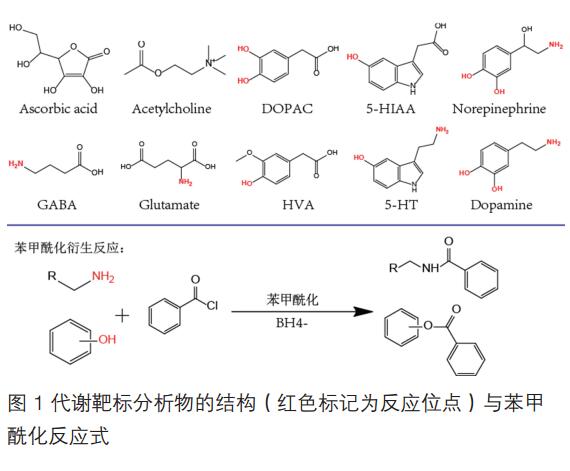
2.2 standard solution configuration:
All analytes were mixed with the mother liquor and diluted to a certain concentration with artificial cerebrospinal fluid . The benzoylation was carried out as described in 2.1 . The obtained samples were analyzed by HPLC-MS/MS and quantified by external standard method.
2.3 HPLC-MS/MS method:
Separation was performed using Thermo Scientific Accela TM 600 HPLC . The Thermo Scientific TSQ Quantum Access MAX series triple quadrupole mass spectrometry method was edited using EZ Method mode. The main parameters of timed selection reaction monitoring timed SRM are shown in Table 1. The remaining analysis conditions are shown in Table 2 and 3. .
2.4 Data Processing :
Using Thermo Scientific TraceFinder TM software (version 3.2) for data processing.
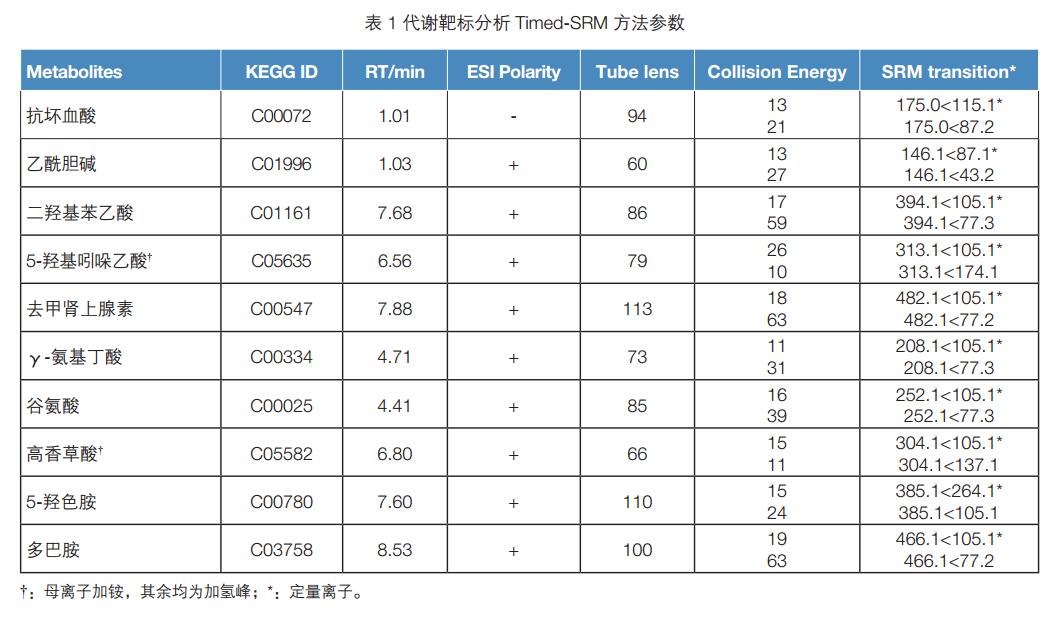
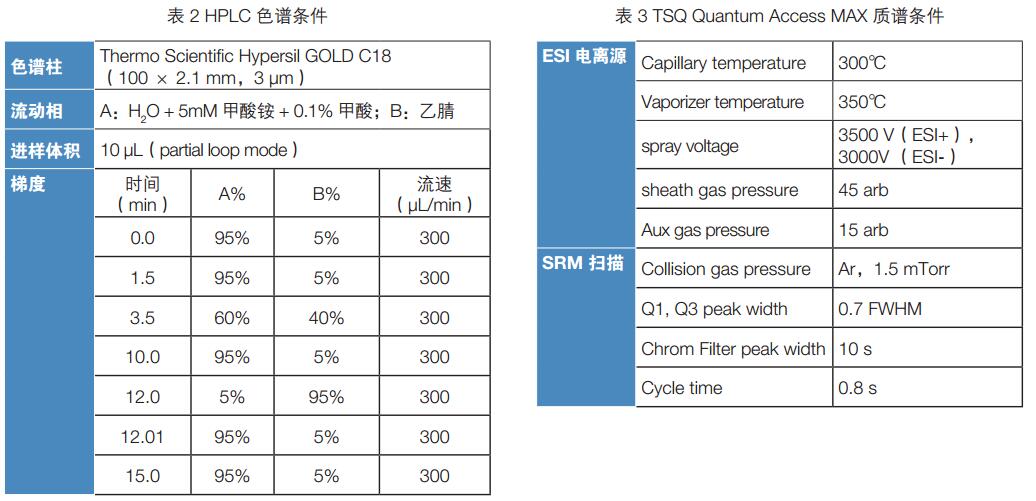
3. Results and discussion
In the pre-column derivatization reaction, the target metabolite has 1~3 phenolic hydroxyl or amine sites combined with benzoyl group (except acetylcholine and ascorbic acid), which brings about the increase of hydrophobicity and the improvement of ESI ionization activity, making the method The specificity and sensitivity of the direct derivatization method are significantly improved. Figure 2 is a chromatogram of each metabolite under experimental conditions, and the peak shape is well symmetric. Figure 3 shows the MS/MS spectrum and the cleavage pattern of dopamine and high vanillic acid-derived products. When the benzoyl derivative MS/MS is broken, it will produce extremely advantageous m/z 105.1C7H5O+ fragments, which is also very helpful to ensure The sensitivity of the detection method is significantly improved.
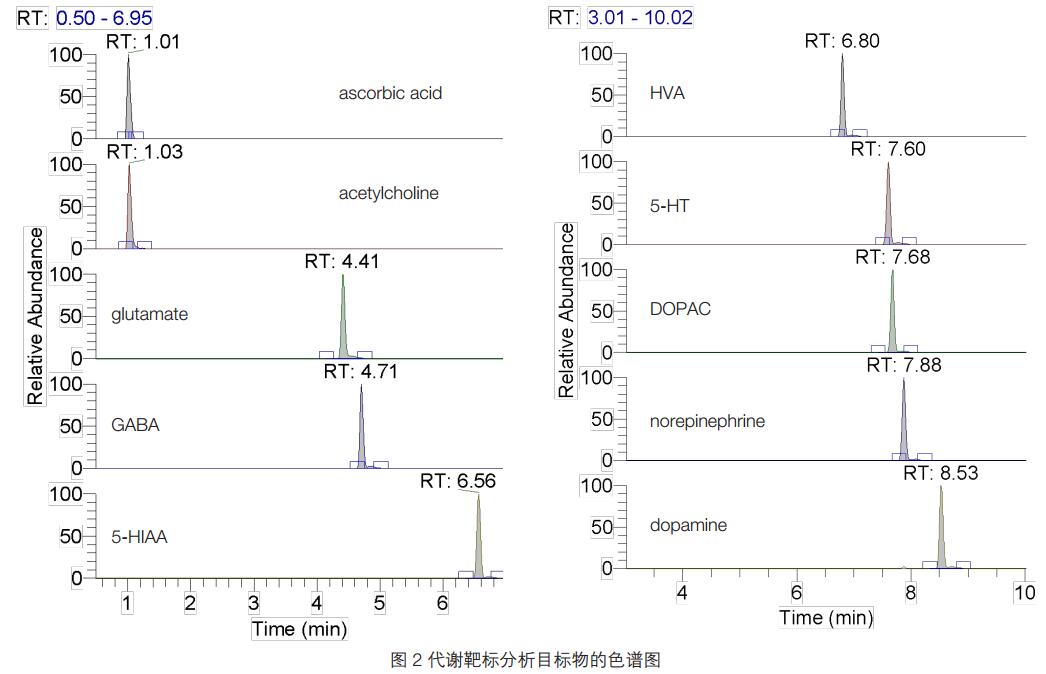
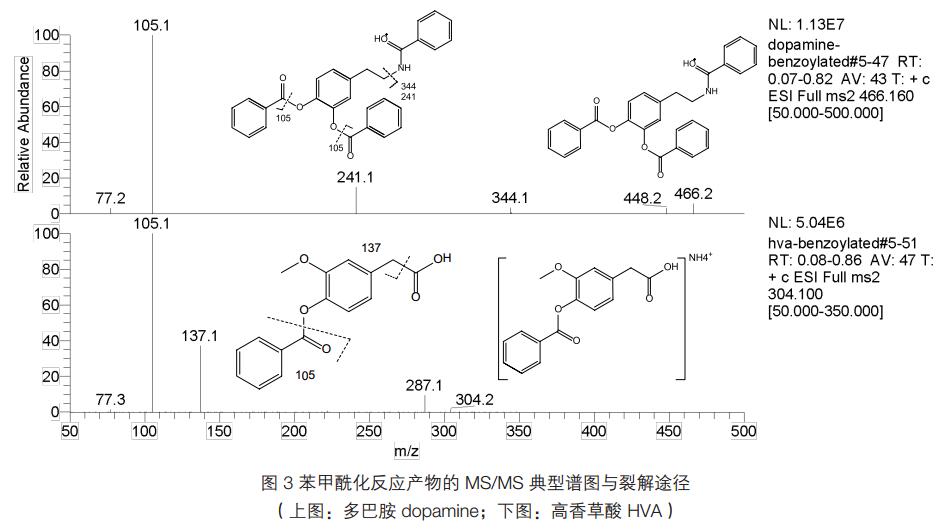
Figure 4 shows the results of the quantitative data processing of the metabolic target of this experiment using TraceFiner software. TraceFinder's highly integrated information display and parallel processing capabilities are especially suitable for high-throughput data processing in large sample metabolic target analysis. The pre-column derivatization method used in this experiment is easy to operate and the reaction is rapid and sufficient. Methodological studies have shown that the metabolic target analysis method has good linearity, reproducibility and stability. Using TSQ Quantam Access MAX mass spectrometry can obtain detection sensitivity far below ng/mL (ppb) level, which can fully satisfy such neuroactive substances. Technical requirements for physiological concentration determination. Table 4 shows partial results of the actual samples of normal mouse cerebrospinal fluid in neuropharmacological experiments using the methods herein.


4 Conclusion
In this paper, we used TSQ Quantum Access MAX tandem liquid and benzoylation pre-column derivatization to establish a metabolic target analysis method for rapid and high sensitivity and high specificity detection of trace nerve active substances in cerebrospinal fluid and brain microdialysis solution. It can be applied to related fields such as neurobiology and neuropharmacology.
references:
[1] Andrej Kovac, et al, Talanta 119 (2014) 284–290
[2] Peng Song, et al, Anal. Chem. 2012, 84, 412-419
3 Ply Breathable Face Masks,Non-Woven Disposable face Mask,Medical Disposable Face Mask,Medical Disposable Face Mask
Dongguan Keyutai Mask Co., Ltd. , https://www.maskkytai.com